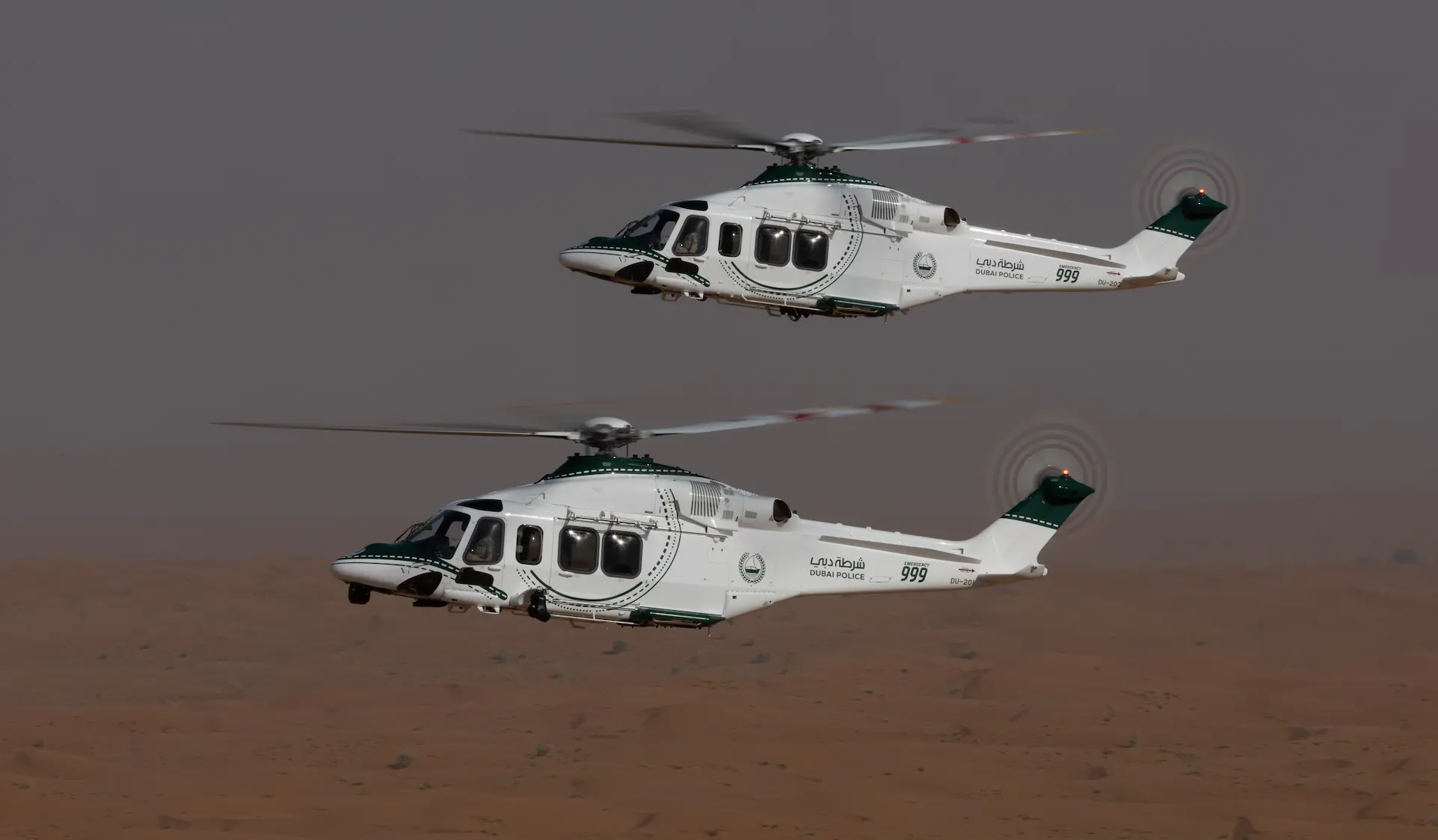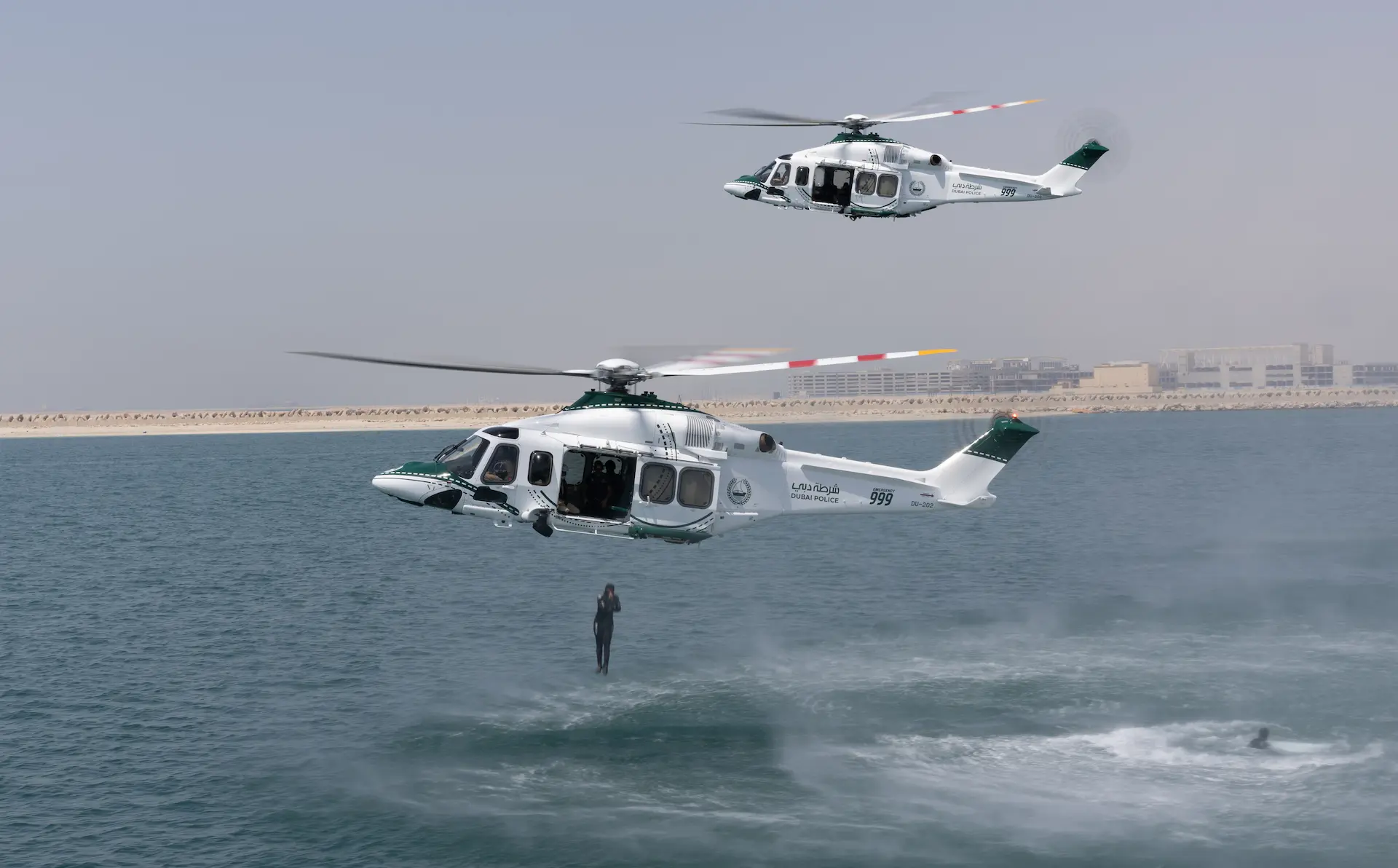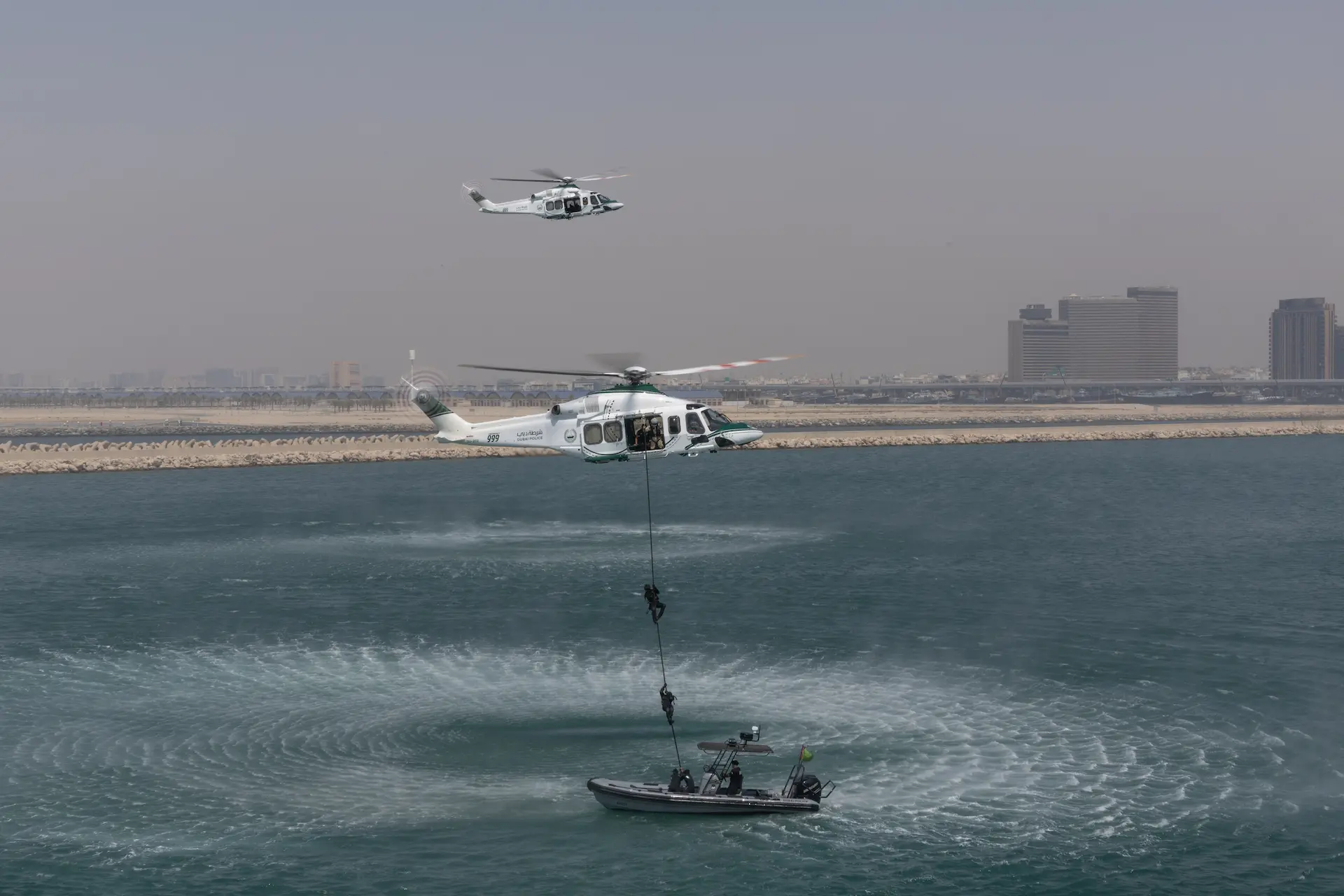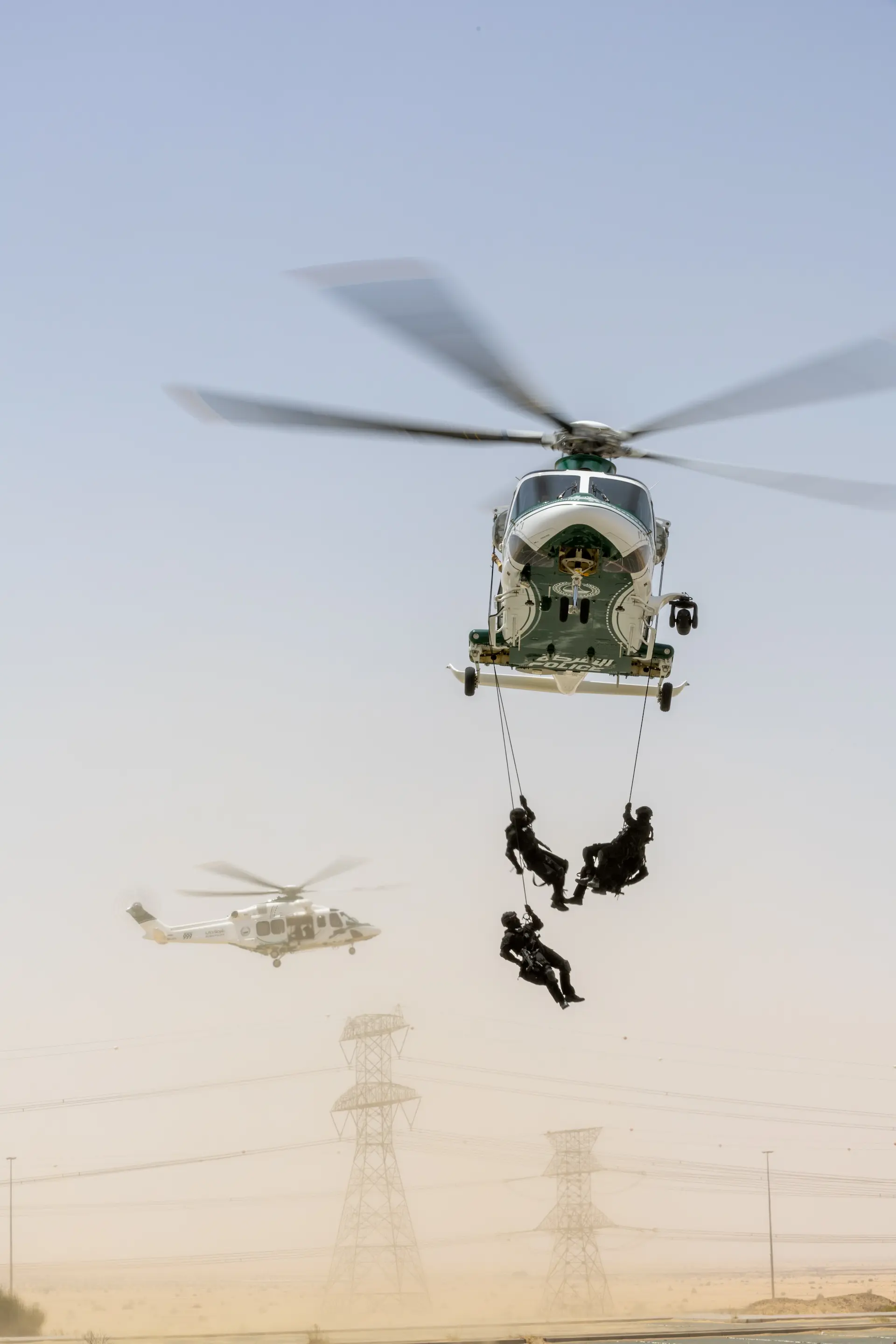Operating from Dubai International Airport, the Dubai Air Wing serves the aviation needs of the government of the Emirate of Dubai. Although a single entity, the Air Wing includes separately named ‘divisions’, including the Dubai Police Air Wing and the Dubai Royal Flight. HeliOps’ Ned Dawson spoke to Ali Almheiri, Director of Dubai Police Air Wing about the division’s operation.
First Operations
The Dubai Air Wing first began helicopter operations in 1972 using the Bell 206 JetRanger and foreign pilots; (2x Bell 205s added 1974) operating VIP missions and occasionally assisting police. Training for national personnel began in 1978 and in the early 1980s, the police commenced operations with the larger Bolkow BO-105. The division was part of the Dubai Air Wing in a structure that remains unchanged to the present day and though operations and administration are now under the control of Dubai Police Headquarters, many links remain today.

Introduction of the Bolkows enabled an increase in capabilities, due to the larger aircraft’s greater internal capacity and hoist capability. Agusta A109-K2s and AB412s then replaced the older Bolkows in 1994, with the JetRanger retained for lighter work such as aerial filming. The Police Air Wing base location has moved within Dubai International Airport as both the Air Wing and the airport have experienced growth.
Colonel Flight Instructor Ali Almheiri was a duty pilot with the police from 1995 until 2012 and was then seconded to the Royal flight from 2012, before returning to the police Air Wing in 2018 as its director. Early in his tenure as director, Almheiri was involved with the project to replace the police wing’s then A109s with Leonardo’s newer AW139 model. He advised that the decision to go with the AW139 was made simple by virtue of the Royal flight’s existing AW139 operation, explaining, “If you’re going to build a fleet of a new type, you need new engineers, new tooling, logistics and so forth. Because we are all a single Air Wing and the Royal flight already operated the AW139, all those maintenance, technical, training and logistical requirements were already in place. Our maintenance is all done by the Royal Flight so really, all we had to do for the type change was convert our pilots to the 139.”

Unit Strength
The unit has a complement of 53 police staff, comprising twenty pilots, tactical police crewmembers and administration staff, while medical personnel are all provided by the ambulance service. New Police Air Wing pilots are trained from ab-initio with training provided by Horizon Aviation which is a dedicated flight training operator within the United Arab Emirates. The current pilot roster includes both licensed civil and certificated ex-military pilots, but Almheiri explained that the intention is to move away from employing those from the military to build a complement of fully licensed, civil-trained commercial pilots over time. The Air Wing already has three female pilots on strength and the plan is to be able to eventually field a full female crew, even including a female SWAT (Special Weapons And Tactics) unit.
The Police Air Wing operates three AW139s. All are fitted out as multi-role platforms, reflecting the mission profiles flown by the wing. Unlike many law enforcement aviation operations, most of the Police wing’s flying is EMS work, due to there being no dedicated EMS operators in Dubai. Although the 139s are fully kitted out as EMS machines, they are also equipped with a rescue hoist and a compact Star SAFIRE 380-HDc FLIR camera turret for police patrol needs. “We combined the mission camera with the EMS in the mission console so every time we fly, the camera is available, and EMS is available, and sometimes even the hoist is available.” Almheiri stated. “Because we cover EMS, Police and SAR all at the same time, we had to configure the aircraft very carefully.”

Although Leonardo and other European companies offered to provide the AW139’s EMS fit out, Dubai chose to go with American company Air Methods for their interiors. That increased the timeframe for completion as Air Methods was a new company for Leonardo to deal with, but Almheiri said that the result was a very high-quality product which works extremely well, particularly noting the new stretcher-mounting mechanism that enabled one-handed operation and stretcher rotation for loading and transit. He also opined that the AW139’s excellent hot and high performance is a real benefit to the Air Wing’s operations and its area of operations where ambient temperatures can typically be at up to 50oC in the desert and mountain terrain.
EMS and Police Work
Dubai boasts one of the lowest crime rates in the world and Almheiri acknowledged that as the reason for the amount of EMS duty in the Air Wing’s workload. “There are always traffic accidents, and we are allowed to land off-airport on or adjacent to the roads to uplift casualties,” he commented. “Perhaps that may change over time as buildings get larger and more densely packed, and more hospitals are built so distances to get patients to a hospital for treatment get smaller, but in more remote areas and the desert, who else is going to be able to reach victims quickly?” He added that although calls to accidents have reduced over recent years as urban facilities have increased, with new trauma centers and private hospitals appearing, the Air Wing flies every day and operates a patrol system that covers the desert, offshore and the cities, with a constantly available EMS response.
The Air Wing also supports the neighboring Emirates and will transport police units or specialist units to incidents in those regions if required. Almheiri remarked that people’s awareness of new technology and the high prevalence of surveillance cameras discouraged offending, helping to maintain security and the low crime rate within the UAE. Despite this, he added, Police and Air Wing training had to accept the possibility of any occurrence by being prepared and on standby for a ‘worst-case’ incident. Consequently, training scenarios are run every year involving such incidents as crashes on the runway, high speed vehicle pursuits, canine unit cooperation, counter-terrorism operations and suspect surveillance.

Despite the preponderance of EMS demand, police missions are an equally high priority, so the unit spends much time and effort in preparing for any eventuality. The AW139s’ onboard mission equipment includes a digital downlink for real-time data transfer to police headquarters operational command center. “Right now, much of what we do is training but we do undertake police missions and transport engineers to the police radio station over the mountain. Police SWAT has currency requirements and we train with them regularly for helicopter operations, how to get in, aerial sniping, how to sit in the aircraft and how to rope out, so they are ready for either ground or air transportation,” said Almheiri, who added that because Dubai is such a safe country, such operations have so far not been conducted for real, only carried out in training – “but you never know when this will become a reality as we have seen in many other countries”.
The unit is available on a 24/7 standby basis, with crews working a 24hr, 8:00am to 8:00am shift followed by two days off duty. Aside from any callouts, three one-hour patrols are flown each shift, in the morning, evening and night. “Each patrol flight is one hour in duration, and we can effectively cover the whole city in that time, although we will sometimes avoid areas that are being covered by ground units, instead covering desert areas that no-one else can reach,” Almheiri said. He explained that the focus of patrols varied seasonally, with summer patrols focusing on the coastline and offshore, where large numbers of people swim or go boating. During winter there is much less swimming and on-water activity, so the patrol focus shifts to the inland mountain and desert areas where motor vehicle activity is high. Almheiri sees the intense heat as more of a problem for the people the Air Wing goes out to aid than for the crews and said that it is not uncommon to have to rescue foreign visitors who head into the desert to sightsee, then get lost or stranded. “We get a lot of those, especially with European and South American tourists who have no idea where they are when they call us. We have to try to figure it out from their last known location and approximate direction of travel.”

Airport Challenge
Operating from a busy international airport poses obvious challenges in regard to traffic and facilities, but Almheiri stated that it did not present any insurmountable problems. “They are really good to us. If we have an emergency, they will stop the traffic and give us priority to go. My callsign reflects the mission, so I will be ‘Police 800’ on normal flights, but I have a dedicated squawk code and will change the callsign to ‘Rescue 800’ if I have to respond to an accident or other emergency, so the controller will immediately recognize the increased level of urgency,” Almheiri related. He advised that the specified maximum response time for liftoff on a rescue mission is an impressively fast the average is four minutes.
Future Direction
Looking to the future, Almheiri has definite ideas on the direction he would like to see the unit take. “With the helicopters, we already have the latest aircraft right now so there is no need to look at others any time soon. With the Air Wing however, I would like to have more crews available so we can routinely run more than one machine at the same time. At the moment everything has to be done by the one on-duty crew and I have to call another standby crew if anything else comes up,” Almheiri explained, adding that the extra time taken would always be a concern when response time is critical. He pointed out that the planned new base would enable the construction of better facilities that could include a training center, not just for the Air Wing crews, but also for other agencies and units that the wing could cooperate with.

Regardless of any future expansion or change, and while the structure and mission profile of the Dubai Police Air Wing may not be typical, the standard of its equipment and its effectiveness in the required mission roles is unquestioned.
 HOME
HOME



